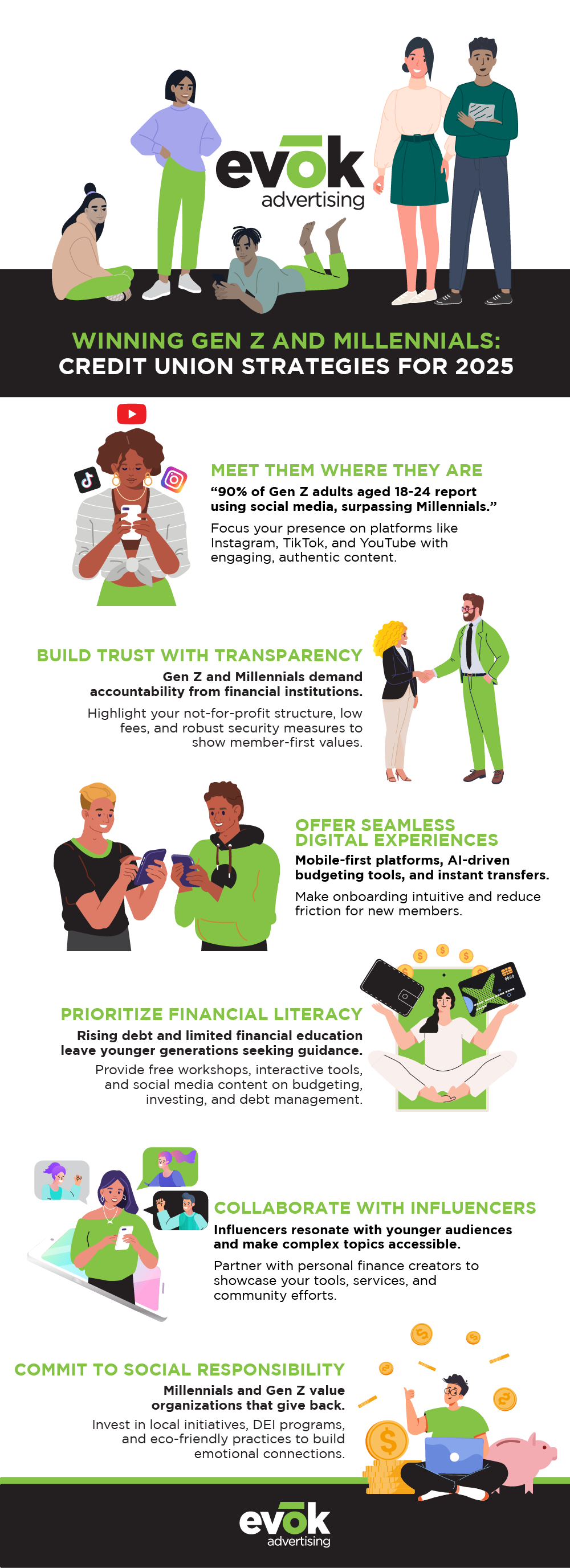
Credit Union Marketing 101: Member Acquisition Strategies to Capture Gen Z and Millennial Members in 2025
As we move into 2025, financial institutions face an unprecedented shift in consumer behavior, especially among younger generations like Millennials and Gen Z. These groups are no longer just the “future” of banking—they’re the now. With Gen Z making up a significant portion of the workforce and Millennials continuing to shape the economic landscape, credit unions must adapt quickly to remain relevant in a fiercely competitive market.
Unlike traditional financial institutions, credit unions have a unique opportunity to stand out by offering member-focused services and community-driven values. However, attracting and retaining these younger members requires more than competitive interest rates and convenient services—it requires a deep understanding of their expectations and an ability to meet them where they are.
A seamless digital experience, authentic social engagement, and a clear stance on social issues are non-negotiable for Gen Z and Millennials. These generations expect their financial institutions to provide innovative products and demonstrate trust, transparency, and social responsibility. In this blog, we’ll explore the proven marketing strategies to help credit unions capture the attention of Gen Z and Millennial members, build long-lasting relationships, and position themselves as forward-thinking, member-first institutions in 2025 and beyond.

Understanding Gen Z and Millennial Consumer Behavior
To effectively attract and retain younger members, credit unions must first understand what drives the financial decisions of Gen Z and Millennials. While both generations have some commonalities—such as a preference for digital-first services and a strong desire for convenience—there are distinct differences in how they engage with financial institutions.
Gen Z: A Digital-First Generation
Gen Z, born between 1997 and 2012, grew up with smartphones and social media. This generation has never known a world without constant connectivity, significantly shaping their expectations regarding financial services. 90% of Gen Z adults aged 18-24 report using social media, surpassing Millennials. This heavy use of social media underscores the need for financial institutions to meet Gen Z where they are: online and on the go.
Gen Z is also more discerning when choosing financial institutions. A study by McKinsey found that many Gen Zers who switched financial providers cited better customer service, more favorable interest rates, and a commitment to community support as key motivators. This highlights the fact that younger consumers seek values-driven experiences from the brands they engage with beyond digital convenience.
Millennials: The Financial Pioneers
Millennials (born between 1981 and 1996) represent a different but equally important demographic for credit unions. While Millennials are just as tech-savvy as Gen Z, they have had the opportunity to witness the evolution of digital banking and the financial landscape. As a result, they are more likely to value a balance of innovation and stability. Millennials expect digital-first services but strongly value transparency and trust in their financial institutions.
A key characteristic of Millennials is their strong desire for personalized experiences. Financial products that cater to their unique life stages—first-time home buying, student loans, or retirement planning—are crucial to keeping them engaged. Understanding the diverse needs of Millennials, from financial independence to family planning, will help credit unions tailor their offerings effectively.
Building Trust Through Transparency, Security, and Authenticity
Trust is one of the most critical factors for Millennials and Gen Z when choosing a financial institution. Having grown up during financial crises, data breaches, and the rise of fintech disruptors, these generations demand more transparency and accountability from their banks and credit unions. Credit unions can meet this expectation by emphasizing their not-for-profit structure, which inherently prioritizes member needs over profit. Clearly communicating membership benefits—such as lower fees, better loan rates, and a say in decision-making—reinforces the message that members are valued and respected.
It is equally important to demonstrate a commitment to security and privacy. Millennials and Gen Z know the risks of sharing personal data online. Credit unions can reassure members their financial information is safe by investing in robust cybersecurity measures and regularly communicating updates about data protection efforts. Transparency about how member data is used can further build confidence.
Authenticity also plays a role in building trust. Collaborating with influencers who genuinely align with the credit union’s values can make a lasting impact. For example, an influencer sharing how they trust the credit union with their savings or loan needs creates relatable, real-world endorsements. These efforts position the credit union as a trustworthy partner for younger generations.
The Importance of Financial Literacy for Younger Generations

Gen Z and Millennials face unique financial challenges leaving them feeling overwhelmed or unprepared. Rising student debt, escalating housing costs, and limited access to financial education have created a gap in their ability to manage their money confidently. This presents an opportunity for credit unions to step in as trusted educators, equipping younger members with the knowledge and tools they need to succeed.
Offering financial literacy programs is an impactful way to engage these demographics. Free workshops or webinars on budgeting, investing, and debt management can help demystify essential financial topics. Interactive tools, such as student loan calculators or retirement planning trackers, provide hands-on support younger members can use daily. Additionally, a robust content marketing strategy—including blogs, podcasts, and video series—can further establish credit unions as valuable resources for financial education.
Beyond offering these resources, credit unions can harness the power of influencers to amplify their message. Collaborating with financial influencers on platforms like TikTok, Instagram, or YouTube can make educational content more relatable and accessible. Influencers specializing in personal finance can break down complex topics into engaging, bite-sized pieces while endorsing the credit union’s services. For example, an influencer could demonstrate how to use the credit union’s budgeting tool or share personal stories about how credit union membership helped them achieve a financial milestone.
By blending traditional education efforts with influencer marketing, credit unions can reach Gen Z and Millennials on the platforms they already use and trust. This strategy positions the credit union as a thought leader and builds credibility and emotional connections with potential members.
Proven Marketing Strategies for Credit Unions in 2025

A seamless digital experience is one of the most important factors for attracting Millennials and Gen Z to your credit union. These tech-savvy generations expect mobile-first platforms that offer a physical branch’s functionality, from mobile deposits and instant transfers to personalized financial planning tools. Credit unions should invest in AI-driven budgeting assistants and financial trackers to provide added value while ensuring the onboarding process is simple and intuitive. By reducing friction and making it easy for younger consumers to switch, credit unions can position themselves as accessible and forward-thinking institutions.
Social media is another critical avenue for engaging with younger generations. Platforms like Instagram, TikTok, and YouTube offer credit unions the opportunity to share financial education, highlight member success stories, and showcase their community involvement. Short-form content, such as TikTok videos or Instagram Reels, can effectively communicate financial tips or share glimpses into the organization’s mission and culture. Partnering with influencers who align with the credit union’s values can further amplify outreach efforts, providing authentic endorsements resonating with Millennials and Gen Z. By combining creativity with educational campaigns, credit unions can engage audiences in ways going beyond traditional advertising.
Millennials and Gen Z are also drawn to organizations prioritizing community and social responsibility. Credit unions can differentiate themselves from traditional banks by investing in local initiatives such as financial literacy workshops, small business grants, or scholarships. Highlighting efforts to reduce environmental impact, such as adopting paperless processes or funding green initiatives, can resonate with these socially conscious generations. Credit unions should take a clear stance on diversity, equity, and inclusion (DEI) issues to build stronger emotional connections with prospective members. They can foster loyalty and trust by demonstrating a genuine commitment to making a positive impact.
Measuring Success
Implementing these strategies is only the beginning. Credit unions must measure their progress and adapt to changing member expectations to ensure long-term success. Key performance indicators (KPIs) such as member acquisition rates, app downloads, website engagement, and social media metrics can provide valuable insights into the effectiveness of marketing efforts. Retention rates and the lifetime value of members are also critical measures of success. Regularly soliciting feedback through surveys or focus groups allows credit unions to identify areas for improvement and strengthen member relationships.
Your Next Steps in Winning Younger Members

Millennials and Gen Z represent a significant opportunity for credit unions to expand their membership base and build lasting relationships. By embracing innovation, engaging authentically on social media, and demonstrating a commitment to community and social responsibility, credit unions can position themselves as the financial institutions of choice for these influential generations. The good news is that 50% of consumers across all age groups are open to switching their primary financial institution, with 47% of Gen Z and Millennials willing to switch to a credit union. This willingness to switch underscores the potential for credit unions to stand out by offering personalized, values-driven services that meet the expectations of today’s younger consumers.
Now is the time for credit unions to adapt, innovate, and thrive. By focusing on member-first values and forward-thinking strategies, they can build a future-ready institution that resonates with Millennials and Gen Z in 2025 and beyond.
Ready to get started? Contact us today! Book time with our team to discuss effective strategies for younger generations member acquisition.